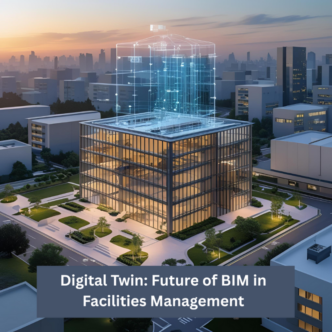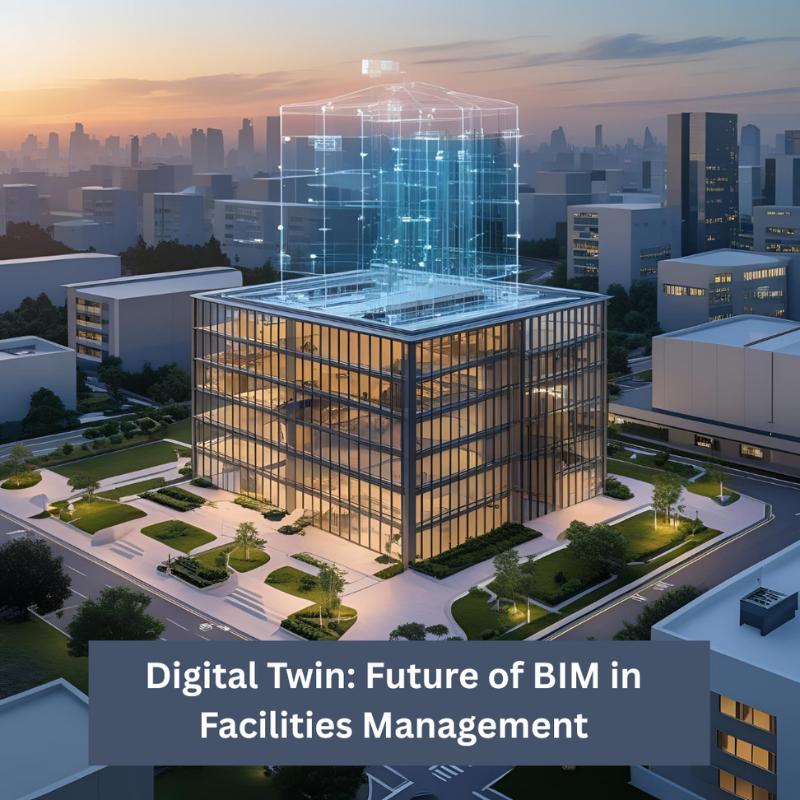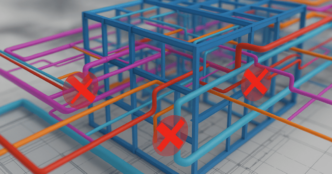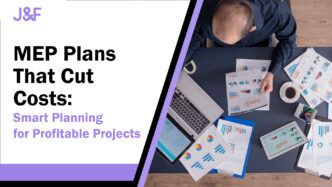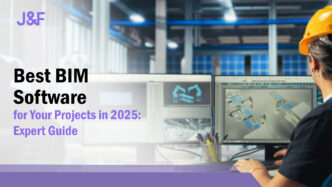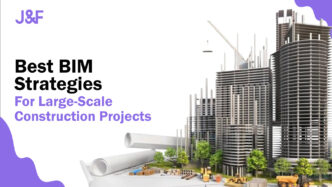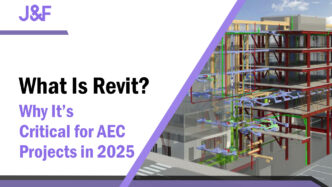The digital revolution has taken the Architecture, Engineering, and Construction (AEC) industry to the next level. The use of BIM and digital twins has played a key role in fueling precision in every aspect of construction, be it design, structural evaluation, or facility management. While BIM still serves as a gold standard for project visualization, the digital twin goes one step further by facilitating real-time data fetched by sensors, drones, etc. Although not used at scale presently, the digital twin is quickly gaining traction among construction engineers and designers seeking ultra-accuracy from BIM models. Let’s take a closer look at:
- Evolution of BIM
- How Digital Twin is reshaping facility management
- It can level up the BIM performance in facilities management.
Understanding the Evolution of BIM
Before we shed light on the rise of the Digital Twin, let’s understand the evolution of BIM:
BIM history dates back to 1970, when it was merely a digital representation tool that focused on parametric interplays. By 1980, it had turned into a 3-D rendering tool that relied on associated data. In 1990, BIM advanced to become more extensive as it was able to integrate construction project data. Ten years later, i.e., in 2002, the AEC industry witnessed significant advancement with BIM-Revit integration.
Fast forward to 2025, BIM has become a gold standard in the AEC industry, effectively catering to design, documentation, analysis, and construction management.
With time, BIM has evolved from simple geometry (known as LOD 1) to an integrated data environment, enabling stakeholders to use a unified communication framework for streamlined workflow.
What was released as a design tool in 1970 has evolved into a life-cycle management solution. From resource management and cost analysis to facility management, BIM can do it all and has continued to push boundaries.
However, despite its accuracy, its static nature can be a concern for stakeholders seeking real-time updates with ultra-precision. That’s where digital twin steps in!
What is a Digital Twin?
A Digital Twin excels at accuracy when it comes to rendering real-time updates. Just like BIM, it offers a digital replica of the physical asset, but its dynamic nature makes it ideal for faculty management, though it can be used in the pre-construction stage. The BIM’s static nature doesn’t necessarily provide a digital twin with an edge. Both are equally pragmatic and significant.
While BIM excels at clash detection, quantity takeoff, design visualization, and project coordination, the Digital Twin can stand out with predictive maintenance, energy optimization, remote monitoring, and emergency response simulation.
Digital twin is often used in conjunction with BIM to streamline facility management, balancing efficacy with quality. It is important to note that BIM models lack real-time updates, unlike digital twins.
Key features of a Digital Twin include:
- Real-time data integration
- Predictive analytics
- Simulation capabilities
- Remote monitoring
- Enhanced visualization
Looking to transition from BIM to Digital Twin? Let our experts guide you.
Digital Twin Vs. BIM: Are They Any Different?
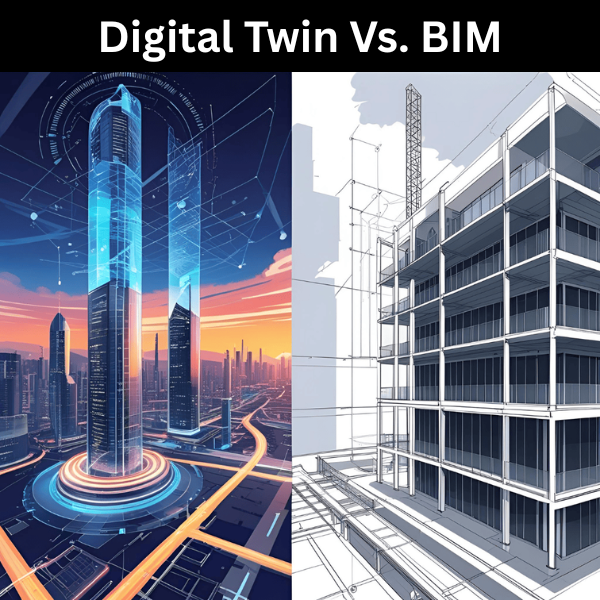
| Aspect | BIM (Building Information Modeling) | Digital Twin |
| Core Function | Renders 3D digital representation of a building’s design and construction data | Enable real-time digital replica of a physical asset via IoT and data feeds |
| Stage Used | Primarily used during design, construction, and early handover | Used during operation, maintenance, and continuous lifecycle management |
| Data Type | Static or periodically updated | Real-time and dynamic |
| Interaction | Visualizes building components, systems, and relationships | Simulates behavior, monitors performance, predicts future states |
| Technology Base | CAD, parametric modeling, clash detection, data-rich object modeling | BIM + IoT + AI + Sensors + Simulation |
| Use Cases | Can help with clash detection, quantity takeoff, design visualization, and project coordination | Useful for predictive maintenance, energy optimization, remote monitoring, and emergency response simulation |
Also Read: Why BIM Outsourcing is Essential for Scaling Your AEC Firm
How Digital Twin Enhances Smart Building Management

Smart Building Management leverages digital twins to optimize and automate building operations. With a digital twin, smart building management can feed on precision-driven data, accurately optimizing the following in real-time:
- Energy system
- HVAC
- Water supplies
- Power consumption
- Theft protection
- Occupant safety
In short, it can enable facility managers to elevate cost savings without compromising management aspects. Digital Twin sits at the forefront of the smart building management and sustainability initiatives.
Need BIM-enabled facility models? Explore our BIM Services tailored for smart building management.
Is Digital Twin the Next Evolution of BIM?
The short answer is — yes.
While BIM for Facility Management provides a solid foundation for managing assets and space, Digital Twin builds upon this foundation by adding real-time operational intelligence.
In essence, the digital twin is not a replacement for BIM but a logical and powerful extension of it. It leverages the structured data of BIM and enriches it with live data streams, turning buildings into adaptive, responsive environments.
Want a unified solution combining BIM and Digital Twin? Get in touch with J&F.
Real-World Applications of Digital Twins in Facilities Management
Digital twins are being leveraged by the following organizations. It helps them reduce their management expenses drastically.

1. Airports and Hospitals
With real-time updates on air quality, energy use, and asset conditions, digital twins enable these institutions to effectively cater to high footfall and complex infrastructure.
2. Corporate Campuses
Digital twin gives a tangible view of occupancy status, enabling managers to optimize space usage and HVAC settings and minimize energy costs.
3. Manufacturing Plants
Digital twins’ predictive maintenance enables production facilities to overcome unplanned downtimes and streamline workflow while having effective control over expenses.
4. Smart Cities
Municipalities are increasingly using digital twins to optimize water supply, traffic movement, and public utilities, leading to improved governance.
Challenges in Implementing Digital Twins
Despite the unprecedented potential, digital twins are not without challenges. These include:

- High Initial Costs: Setting up a digital twin ecosystem with a given facility can be taxing, considering the costs relating to sensor deployment, data integration, and platform development.
- Data Overload: The more data, the more accurate the result. But such data is of no use in the absence of the right analytics tools. Needless to say, procuring such tools can dent the budget of any organization.
- Cybersecurity Risks: Although real-time connectivity serves as a boon, it may expose systems to cyber threats, especially in less secure facilities.
- Interoperability: Ensuring sync between BIM models, IoT systems, and other tools can be challenging for new users.
Also Read: How Generative Design is Shaping the Future of BIM and Structural Engineering
Conclusion
Facility management is a staple for complex projects. With correct tools and technologies like Digital Twin and BIM, facility managers can combine cost savings with streamlined operation and improved safety, ensuring a better experience for occupants.
If you seek to equip your project with such technologies but have no idea where or how to begin, look no further than J&F. As a premier and seasoned partner, J&F is committed to reshaping the AEC industry with advanced solutions tailored to specific needs. Whether you are seeking design assistance, structural evaluation, or uncompromised facility management, J&F can do it all with unparalleled precision and professionalism.
Ready to integrate Digital Twin with your BIM models? Schedule a consultation with J&F today.
